A correct takeoff consists of the model rolling smoothly
along the ground for distance of not less than 4.5 metres, but not greater
than one quarter of a lap. The model then rises smoothly into the air
with a gradual climb and a smooth level-off to normal flight level over
the point at which the model commenced its ground roll. The model continues
on for two smooth laps of normal level flight to the point of original
level-off.
Errors:
Model bounces or becomes airborne too soon, or too late. Take-off climb or level-off are not gradual and smooth. Level-off occurs too soon, or too late. Level-off and normal flight level are not within a height of 1.20 m - 1.80 m.
Errors:
Model bounces or becomes airborne too soon, or too late. Take-off climb or level-off are not gradual and smooth. Level-off occurs too soon, or too late. Level-off and normal flight level are not within a height of 1.20 m - 1.80 m.
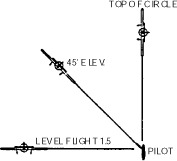
Reverse Wing Over (One required):
Correct reverse wing overs are judged when the model starts from normal level flight, makes a vertical climb and dive, passing directly over the flyer's head, cutting the ground circle in half, and recovers in an inverted position at normal flight level. The model continues for half a lap inverted, to the starting point, then makes a vertical climb and dive over the centre of the circle from inverted flight before recovering at normal flight level.
Errors:
First Half: Model starts at other than normal flight level, wobbles when going into climb. Model does not cross directly over flyer's head. Model does not cross circle in a straight line. Model wobbles or recovers at other than normal flight in an inverted position. Model does not cut circle in same position and direction in second part of manoeuvre.
Second Half: Scores same as first half, reversing the entry and recovery positions.
Correct reverse wing overs are judged when the model starts from normal level flight, makes a vertical climb and dive, passing directly over the flyer's head, cutting the ground circle in half, and recovers in an inverted position at normal flight level. The model continues for half a lap inverted, to the starting point, then makes a vertical climb and dive over the centre of the circle from inverted flight before recovering at normal flight level.
Errors:
First Half: Model starts at other than normal flight level, wobbles when going into climb. Model does not cross directly over flyer's head. Model does not cross circle in a straight line. Model wobbles or recovers at other than normal flight in an inverted position. Model does not cut circle in same position and direction in second part of manoeuvre.
Second Half: Scores same as first half, reversing the entry and recovery positions.
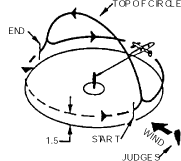
Consecutive Inside Loops (3 required):
Correct loops are judged when the model starts from normal flight level and makes a series of three smooth round loops, all in the same place with the bottoms of the loops at normal flight level and the tops of the loops with the line(s) at 45 degrees elevation. The model then continues for another half loop, recovering inverted and descending to normal flight level, flying two laps before being judged for inverted flight.
Errors:
Loops are rough and irregular (i.e. egg-shaped, hexagonal, etc.). Bottoms of loops are not at 1.20 - 1.80 m height. Tops of loops vary more than 0.60 m, plus or minus of the 45 degrees elevation point. Second and third loops vary more than 0.60 m from the path of the first loop.
Correct loops are judged when the model starts from normal flight level and makes a series of three smooth round loops, all in the same place with the bottoms of the loops at normal flight level and the tops of the loops with the line(s) at 45 degrees elevation. The model then continues for another half loop, recovering inverted and descending to normal flight level, flying two laps before being judged for inverted flight.
Errors:
Loops are rough and irregular (i.e. egg-shaped, hexagonal, etc.). Bottoms of loops are not at 1.20 - 1.80 m height. Tops of loops vary more than 0.60 m, plus or minus of the 45 degrees elevation point. Second and third loops vary more than 0.60 m from the path of the first loop.

Inverted Flight (2 laps):
Correct inverted flight is judged when the model makes two smooth, stable laps at normal flight level.
Errors:
Height is not 1.20 m - 1.80 m. Height varies more than 0.60 m.
Correct inverted flight is judged when the model makes two smooth, stable laps at normal flight level.
Errors:
Height is not 1.20 m - 1.80 m. Height varies more than 0.60 m.
Consecutive Outside Loops (three
required):
Correct loops are judged when model starts from inverted position at normal flight level and makes a series of three smooth, round loops, all in the same place, with the bottoms of the loops at normal flight level and the tops of the loops with the line(s) at 45 degrees elevation. The model then continues for another half loop, recovering at normal flight level.
Errors:
Loops are rough and irregular (i.e. egg-shaped, hexagonal, etc.). Bottoms are not at 1.20 m - 1.80 m height. Tops of loops vary more than 0.60 m, plus or minus, of the 45 degree elevation point. Second and third loops vary more than 0.60 m from the path of the first loop.
Correct loops are judged when model starts from inverted position at normal flight level and makes a series of three smooth, round loops, all in the same place, with the bottoms of the loops at normal flight level and the tops of the loops with the line(s) at 45 degrees elevation. The model then continues for another half loop, recovering at normal flight level.
Errors:
Loops are rough and irregular (i.e. egg-shaped, hexagonal, etc.). Bottoms are not at 1.20 m - 1.80 m height. Tops of loops vary more than 0.60 m, plus or minus, of the 45 degree elevation point. Second and third loops vary more than 0.60 m from the path of the first loop.
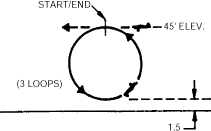
Consecutive Inside Square Loops
(two required):
Consecutive inside square loops are judged correct when the model starts from normal flight level and flies a square course consisting of two loops, each with four inside turns of approximately 1.5 metres radius and straight equal sized segments, with bottom segments at normal flight level and top segments as inverted flight at 45 degrees elevation. The two bottom corners are equal and so are the two top corners. Manoeuvre begins and ends with the model in level flight at the point of start of the first turn.
Errors:
Model wobbles on turns. Lower height is not between 1.20 m - 1.8 m. Upper height is not within 0.60 m of the 45 degree elevation point. Turns are not precise and exceed 2.10 m radius. Sides of loops are not equal. Second loop is not in the same flight path as the first loop.
Consecutive inside square loops are judged correct when the model starts from normal flight level and flies a square course consisting of two loops, each with four inside turns of approximately 1.5 metres radius and straight equal sized segments, with bottom segments at normal flight level and top segments as inverted flight at 45 degrees elevation. The two bottom corners are equal and so are the two top corners. Manoeuvre begins and ends with the model in level flight at the point of start of the first turn.
Errors:
Model wobbles on turns. Lower height is not between 1.20 m - 1.8 m. Upper height is not within 0.60 m of the 45 degree elevation point. Turns are not precise and exceed 2.10 m radius. Sides of loops are not equal. Second loop is not in the same flight path as the first loop.
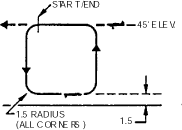
Consecutive Outside Square Loops
(two required):
Consecutive outside square loops are judged correct when the model starts from level flight at 45 degrees elevation and flies a square course (starting with a vertical dive) consisting of two loops, each with four outside turns of approximately 1.5 metres radius and straight equal sized segments with bottom segments at normal flight level and top segments as level flight at 45 degrees elevation. The two bottom corners are equal and so are the two top corners. Manoeuvre begins and ends with the model in level flight at the point of start of the first turn.
Errors:
Model wobbles on turns. Lower height is not within 1.20 m - 1.80 m. Upper height is not within 0.60 m of the 45 degree elevation point. Turns are not within 0.60 m of the 45 degree of the 45 degree elevation point. Turns are not precise and exceed 2.10 m radius. Sides of loops are not equal. Second loop is not in the same flight path as the first loop.
Consecutive outside square loops are judged correct when the model starts from level flight at 45 degrees elevation and flies a square course (starting with a vertical dive) consisting of two loops, each with four outside turns of approximately 1.5 metres radius and straight equal sized segments with bottom segments at normal flight level and top segments as level flight at 45 degrees elevation. The two bottom corners are equal and so are the two top corners. Manoeuvre begins and ends with the model in level flight at the point of start of the first turn.
Errors:
Model wobbles on turns. Lower height is not within 1.20 m - 1.80 m. Upper height is not within 0.60 m of the 45 degree elevation point. Turns are not within 0.60 m of the 45 degree of the 45 degree elevation point. Turns are not precise and exceed 2.10 m radius. Sides of loops are not equal. Second loop is not in the same flight path as the first loop.
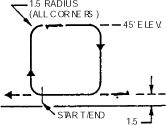
Consecutive Inside Triangular Loops
(2 required):
Correct triangular loops are judged when the model starts from normal
level flight and flies a triangular course, starting and ending with
the base. The three sides of equal length and the three corner angles
of equal size. The top corner must be placed at 45 degrees elevation.
The second triangular loop must be flown in the same flight path as
the first one. All corners must be smooth, precise and of approximately
1.5 metre radius.
Errors:
Model starts at a height other than between 1.20 m - 1.80 m. Turns are
rough and wobbly or exceed 2.10 m radius. Peak of second turns is not
within 0.60 m of the 45 degrees elevation point. Sides are wobbly and
not equal in length. Second loop is not in the same flight path of the
first loop.

Horizontal eights are to be entered and completed at the intersection point of the circles and exit at the same point. The inside loop must be flown first. Correct eights are judged when the model makes two eights, each consisting of two round circles or loops of the same size, tangent to each other, and in a horizontal line. The model must enter the eight from normal flight level and be vertical at the intersection point of tangency of the circles. The eights must be symmetrical. At the top of each circle the model must be at the 45 degrees elevation point; the bottoms of circles must be at normal flight level.
Errors:
Model is not vertical at entry. Model at top of circles is not within 0.60 m of 45 degrees elevation point. Bottom of circles not within 1.20 m - 1.80 m height. Loops are not round and equal in size. Point of intersection varies. Second eight is not in the same position as the first.
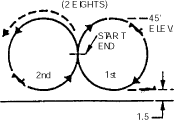
Square Horizontal Eights (2 required):
The eight is to be entered in the direction of the climbing sides of the loops, and after completion of two eights exit is made in the same direction. The inside loop must be flown first. Correct eights are judged when the model starts a vertical climb and makes a modified inside square loop followed by a modified outside square loop ending with a vertical climb at the same point. The loops are modified so their climbing sides are vertical, and the loops are tangent to each other along these sides, and the turns starting and ending the climbs are 90 degrees. The top sides are slightly shorter than the remaining sides which are of equal length. The manoeuvre is repeated to form two eights. Tops of loops must be at 45 degrees elevation, bottom of loops must be at normal flight level, and all turns must be smooth, precise and of approximately 1.5 metres radius.
Errors:
Corners exceed 2.10 metres radius. Sides are not straight. Vertical sides and bottom sides are not equal in length. Loops are not equal in size. Top and bottom sides are not horizontal. Turns starting and ending the climbs are not 90 degrees. Tops of loops are not within 0.60 metres from 45 degrees elevation. Bottom of loops are not within 1.20 m - 1.80 m in height. The position of the climbing sides varies. Second eight is not in the same position as the first one.
The eight is to be entered in the direction of the climbing sides of the loops, and after completion of two eights exit is made in the same direction. The inside loop must be flown first. Correct eights are judged when the model starts a vertical climb and makes a modified inside square loop followed by a modified outside square loop ending with a vertical climb at the same point. The loops are modified so their climbing sides are vertical, and the loops are tangent to each other along these sides, and the turns starting and ending the climbs are 90 degrees. The top sides are slightly shorter than the remaining sides which are of equal length. The manoeuvre is repeated to form two eights. Tops of loops must be at 45 degrees elevation, bottom of loops must be at normal flight level, and all turns must be smooth, precise and of approximately 1.5 metres radius.
Errors:
Corners exceed 2.10 metres radius. Sides are not straight. Vertical sides and bottom sides are not equal in length. Loops are not equal in size. Top and bottom sides are not horizontal. Turns starting and ending the climbs are not 90 degrees. Tops of loops are not within 0.60 metres from 45 degrees elevation. Bottom of loops are not within 1.20 m - 1.80 m in height. The position of the climbing sides varies. Second eight is not in the same position as the first one.

Vertical Eights ( 2 required):
Vertical eights are to be started at the point of 45 degrees elevation and finished at the same point in inverted flight. The inside loop must be flown first. Correct eights are judged when the model makes two eights, each consisting of two round circles or loops of the same size, tangent to each other, and in a vertical line. The model must be horizontal at the intersection point of tangency of the two circles. The eights must be symmetrical, the top of the heights at a point 90 degrees over flyer's head, and the bottom of the heights at normal flight level.
Errors:
Model is not horizontal at entry. Entry is not within 0.60 m of the 45 degrees elevation point. Tops of eights are not within 1.20 m from the 90 degrees point. Bottoms of eights are not at a height between 1.20 m - 1.80 m. Loops are not round and equal in size. Point of intersection varies. Second eight is not in the same position as the first.
Vertical eights are to be started at the point of 45 degrees elevation and finished at the same point in inverted flight. The inside loop must be flown first. Correct eights are judged when the model makes two eights, each consisting of two round circles or loops of the same size, tangent to each other, and in a vertical line. The model must be horizontal at the intersection point of tangency of the two circles. The eights must be symmetrical, the top of the heights at a point 90 degrees over flyer's head, and the bottom of the heights at normal flight level.
Errors:
Model is not horizontal at entry. Entry is not within 0.60 m of the 45 degrees elevation point. Tops of eights are not within 1.20 m from the 90 degrees point. Bottoms of eights are not at a height between 1.20 m - 1.80 m. Loops are not round and equal in size. Point of intersection varies. Second eight is not in the same position as the first.

Hourglass Figure (one required):
Correct hourglass figure is judged when the model starts from normal flight level and flies an hourglass course starting with an abrupt turn followed by an inverted climb, turns into a wingover path across the circle centre for a distance equal to half the total climb, turns into an inverted dive, and recovers at normal flight level. The flight paths of the climb and the dive cross at 45 degrees elevation. The four rounded corners of the figure shall have a radius of approximately 1.50 metres and the flight path forms two equilateral triangles of equal size, turned peak to peak and one in vertical line above the other.
Errors:
Manoeuvre starts at other than the normal flight level of 1.20 m - 1.80 m. Turns are rough and wobbly or exceed 2.10 m radius. Top of figure is not within 0.60 m from the 90 degrees position over the pilot's head. Triangle segments are not of equal length. The manoeuvre is not symmetrical around the vertical line through the crossing point at 45 degrees elevation. Recovery is not at normal flight level of 1.20 m - 1.80 m.
Correct hourglass figure is judged when the model starts from normal flight level and flies an hourglass course starting with an abrupt turn followed by an inverted climb, turns into a wingover path across the circle centre for a distance equal to half the total climb, turns into an inverted dive, and recovers at normal flight level. The flight paths of the climb and the dive cross at 45 degrees elevation. The four rounded corners of the figure shall have a radius of approximately 1.50 metres and the flight path forms two equilateral triangles of equal size, turned peak to peak and one in vertical line above the other.
Errors:
Manoeuvre starts at other than the normal flight level of 1.20 m - 1.80 m. Turns are rough and wobbly or exceed 2.10 m radius. Top of figure is not within 0.60 m from the 90 degrees position over the pilot's head. Triangle segments are not of equal length. The manoeuvre is not symmetrical around the vertical line through the crossing point at 45 degrees elevation. Recovery is not at normal flight level of 1.20 m - 1.80 m.

Overhead Figure Eights (2 required):
Overhead eights are to be entered and completed at the intersection point of the circles, directly over the flyer's head, and exit from the same point. The inside loop must be flown first. Correct overhead eights are judged when the model makes two eights, each consisting of two round circles of the same size, with the intersection or point of tangency directly over the flyer's head. The model must enter the eights with a vertical climb through the centre of the circle, and must always point in this direction at the centre of the eights. The eights must be symmetrical and the model at the lowest point of each circle must be at a point of 45 degrees elevation.
Errors:
Model is not vertically overhead at entry. Low point of circles is not within 0.60 m of the 45 degrees elevation point. Loops are not round and equal in size. Point of intersection varies. Second eight is not in the same position as the first.
Overhead eights are to be entered and completed at the intersection point of the circles, directly over the flyer's head, and exit from the same point. The inside loop must be flown first. Correct overhead eights are judged when the model makes two eights, each consisting of two round circles of the same size, with the intersection or point of tangency directly over the flyer's head. The model must enter the eights with a vertical climb through the centre of the circle, and must always point in this direction at the centre of the eights. The eights must be symmetrical and the model at the lowest point of each circle must be at a point of 45 degrees elevation.
Errors:
Model is not vertically overhead at entry. Low point of circles is not within 0.60 m of the 45 degrees elevation point. Loops are not round and equal in size. Point of intersection varies. Second eight is not in the same position as the first.

Four-leaf Clover (one required):
The manoeuvre is entered from level flight at approximately 38 degrees elevation and consists of one full inside loop, level flight, three-fourths of an outside loop, vertical climb, three fourths of an outside loop, level inverted flight, three-fourths of an inside loop, and a vertical climb. The right loops are tangent to the left loops along a vertical plane of symmetry through the centre of the clover leaf, and the bottom loops are tangent at the top loops. The loops are of equal size and they are connected by horizontal and vertical flight paths. The bottom points of the manoeuvre shall be at 1.50 metres height, and the top shall be tangent to the vertical plane through the circle centre. When the last loop is performed, the manoeuvre is made complete by a vertical climb through the centre of the four-leaf clover and a recovery into normal flight level.
Errors:
Entry is not within 0.60 m of 38 degrees elevation point. Loops are rough or not of equal size. Parts connecting loops are not properly horizontal or vertical according to the manoeuvre sketch. Bottoms of lower loops are not at a height between 1.20 m - 1.80 m. Tops of upper loops are not wiithin 1.20 m from the vertical plane through the circle centre. Loops are not properly tangential to form a square pattern. Model recovers before it has flown vertically through the clover pattern.
The manoeuvre is entered from level flight at approximately 38 degrees elevation and consists of one full inside loop, level flight, three-fourths of an outside loop, vertical climb, three fourths of an outside loop, level inverted flight, three-fourths of an inside loop, and a vertical climb. The right loops are tangent to the left loops along a vertical plane of symmetry through the centre of the clover leaf, and the bottom loops are tangent at the top loops. The loops are of equal size and they are connected by horizontal and vertical flight paths. The bottom points of the manoeuvre shall be at 1.50 metres height, and the top shall be tangent to the vertical plane through the circle centre. When the last loop is performed, the manoeuvre is made complete by a vertical climb through the centre of the four-leaf clover and a recovery into normal flight level.
Errors:
Entry is not within 0.60 m of 38 degrees elevation point. Loops are rough or not of equal size. Parts connecting loops are not properly horizontal or vertical according to the manoeuvre sketch. Bottoms of lower loops are not at a height between 1.20 m - 1.80 m. Tops of upper loops are not wiithin 1.20 m from the vertical plane through the circle centre. Loops are not properly tangential to form a square pattern. Model recovers before it has flown vertically through the clover pattern.

Landing:
A correct landing is judged when the model descends smoothly from normal flight level to land with no bounce or unusual roughness, and without any part of the model other than the landing gear having touched the ground. The model comes to a stop within one lap from point of touch-down. The point of touch-down is one lap after the point at which the model begins its descent from level flight. Main wheel(s) or three point landings are permissible.
Errors:
An error is committed whenever the model bounces or when any part of the model other than the landing gear touches the ground. A crash, or a flip over, a belly or upside down landing receives no marks. Descent from level flight is not smooth, or is shorter or longer than one lap. Model does not come to a stop within one lap
A correct landing is judged when the model descends smoothly from normal flight level to land with no bounce or unusual roughness, and without any part of the model other than the landing gear having touched the ground. The model comes to a stop within one lap from point of touch-down. The point of touch-down is one lap after the point at which the model begins its descent from level flight. Main wheel(s) or three point landings are permissible.
Errors:
An error is committed whenever the model bounces or when any part of the model other than the landing gear touches the ground. A crash, or a flip over, a belly or upside down landing receives no marks. Descent from level flight is not smooth, or is shorter or longer than one lap. Model does not come to a stop within one lap
